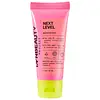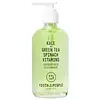What's inside
What's inside
 Key Ingredients
Key Ingredients

 Benefits
Benefits

 Concerns
Concerns

 Ingredients Side-by-side
Ingredients Side-by-side

Water
Skin ConditioningEthylhexyl Palmitate
EmollientPropanediol
SolventGlycerin
HumectantCetearyl Alcohol
Emollient1,2-Hexanediol
Skin ConditioningDicaprylyl Carbonate
EmollientNiacinamide
SmoothingSorbitan Stearate
EmulsifyingGlyceryl Stearate
EmollientBoerhavia Diffusa Root Extract
Skin ProtectingPinus Pinaster Bark Extract
AntioxidantCurcuma Longa Root Extract
MaskingSaccharide Isomerate
HumectantRibose
HumectantSodium PCA
HumectantPyrus Malus Fruit Extract
Skin ConditioningSophora Japonica Flower Extract
Skin ProtectingAllantoin
Skin ConditioningAdenosine
Skin ConditioningBetaine
HumectantCitric Acid
BufferingMangifera Indica Fruit Extract
Skin ConditioningPrunus Armeniaca Fruit Extract
Skin ConditioningRubus Idaeus Fruit Extract
AstringentCitrus Aurantifolia Peel Extract
CleansingCitrus Aurantium Dulcis Peel Extract
Emulsion StabilisingCitrus Paradisi Peel Extract
PerfumingCucumis Melo Fruit Extract
Skin ConditioningImpatiens Balsamina Flower Extract
AstringentVanilla Planifolia Fruit Extract
Skin ConditioningXanthan Gum
EmulsifyingCaprylic/Capric Triglyceride
MaskingCetearyl Olivate
Dipotassium Glycyrrhizate
HumectantDocosahexaenoic Acid
Skin ConditioningEicosapentaenoic Acid
EmollientGlyceryl Olivate
EmollientHydrogenated Rapeseed Alcohol
EmollientHydrogenated Vegetable Oil
EmollientTocopherol
AntioxidantTocopheryl Acetate
AntioxidantTrisodium Ethylenediamine Disuccinate
Tromethamine
BufferingPhosphatidylcholine
EmulsifyingPhytosphingosine
Skin ConditioningPolyglyceryl-4 Oleate
EmulsifyingSorbitan Isostearate
EmulsifyingSorbitan Olivate
EmulsifyingMica
Cosmetic ColorantSorbitol
HumectantStearic Acid
CleansingTetrasodium Glutamate Diacetate
Acrylates/C10-30 Alkyl Acrylate Crosspolymer
Emulsion StabilisingBehenyl Alcohol
EmollientHydroxyethyl Acrylate/Sodium Acryloyldimethyl Taurate Copolymer
Emulsion StabilisingHydroxyacetophenone
AntioxidantCI 77491
Cosmetic ColorantCI 77891
Cosmetic ColorantEthylhexylglycerin
Skin ConditioningWater, Ethylhexyl Palmitate, Propanediol, Glycerin, Cetearyl Alcohol, 1,2-Hexanediol, Dicaprylyl Carbonate, Niacinamide, Sorbitan Stearate, Glyceryl Stearate, Boerhavia Diffusa Root Extract, Pinus Pinaster Bark Extract, Curcuma Longa Root Extract, Saccharide Isomerate, Ribose, Sodium PCA, Pyrus Malus Fruit Extract, Sophora Japonica Flower Extract, Allantoin, Adenosine, Betaine, Citric Acid, Mangifera Indica Fruit Extract, Prunus Armeniaca Fruit Extract, Rubus Idaeus Fruit Extract, Citrus Aurantifolia Peel Extract, Citrus Aurantium Dulcis Peel Extract, Citrus Paradisi Peel Extract, Cucumis Melo Fruit Extract, Impatiens Balsamina Flower Extract, Vanilla Planifolia Fruit Extract, Xanthan Gum, Caprylic/Capric Triglyceride, Cetearyl Olivate, Dipotassium Glycyrrhizate, Docosahexaenoic Acid, Eicosapentaenoic Acid, Glyceryl Olivate, Hydrogenated Rapeseed Alcohol, Hydrogenated Vegetable Oil, Tocopherol, Tocopheryl Acetate, Trisodium Ethylenediamine Disuccinate, Tromethamine, Phosphatidylcholine, Phytosphingosine, Polyglyceryl-4 Oleate, Sorbitan Isostearate, Sorbitan Olivate, Mica, Sorbitol, Stearic Acid, Tetrasodium Glutamate Diacetate, Acrylates/C10-30 Alkyl Acrylate Crosspolymer, Behenyl Alcohol, Hydroxyethyl Acrylate/Sodium Acryloyldimethyl Taurate Copolymer, Hydroxyacetophenone, CI 77491, CI 77891, Ethylhexylglycerin
Water
Skin ConditioningCocamidopropyl Hydroxysultaine
CleansingSodium Cocoyl Glutamate
CleansingSorbeth-230 Tetraoleate
EmulsifyingPolysorbate 20
EmulsifyingSodium Chloride
MaskingAloe Barbadensis Leaf Juice Powder
Skin ConditioningBrassica Oleracea Acephala Leaf Extract
HumectantSpinacia Oleracea Leaf Extract
Skin ConditioningCamellia Sinensis Leaf Extract
AntimicrobialMedicago Sativa Extract
TonicChamomilla Recutita Flower Extract
MaskingTetrahexyldecyl Ascorbate
AntioxidantGlycerin
HumectantPanthenol
Skin ConditioningTocopheryl Acetate
AntioxidantDecyl Glucoside
CleansingSorbitan Laurate
EmulsifyingTetrasodium Glutamate Diacetate
Gluconolactone
Skin ConditioningEthylhexylglycerin
Skin ConditioningMaltodextrin
AbsorbentCitric Acid
BufferingPhenoxyethanol
PreservativePotassium Sorbate
PreservativeSodium Benzoate
MaskingGardenia Jasminoides Fruit Extract
Cosmetic ColorantParfum
MaskingSodium Hydroxide
BufferingSodium Glycolate
BufferingSodium Formate
BufferingHexyl Cinnamal
PerfumingLinalool
PerfumingLimonene
PerfumingCI 75810
Cosmetic ColorantWater, Cocamidopropyl Hydroxysultaine, Sodium Cocoyl Glutamate, Sorbeth-230 Tetraoleate, Polysorbate 20, Sodium Chloride, Aloe Barbadensis Leaf Juice Powder, Brassica Oleracea Acephala Leaf Extract, Spinacia Oleracea Leaf Extract, Camellia Sinensis Leaf Extract, Medicago Sativa Extract, Chamomilla Recutita Flower Extract, Tetrahexyldecyl Ascorbate, Glycerin, Panthenol, Tocopheryl Acetate, Decyl Glucoside, Sorbitan Laurate, Tetrasodium Glutamate Diacetate, Gluconolactone, Ethylhexylglycerin, Maltodextrin, Citric Acid, Phenoxyethanol, Potassium Sorbate, Sodium Benzoate, Gardenia Jasminoides Fruit Extract, Parfum, Sodium Hydroxide, Sodium Glycolate, Sodium Formate, Hexyl Cinnamal, Linalool, Limonene, CI 75810
 Reviews
Reviews

Ingredients Explained
These ingredients are found in both products.
Ingredients higher up in an ingredient list are typically present in a larger amount.
Citric Acid is an alpha hydroxy acid (AHA) naturally found in citrus fruits like oranges, lemons, and limes.
Like other AHAs, citric acid can exfoliate skin by breaking down the bonds that hold dead skin cells together. This helps reveal smoother and brighter skin underneath.
However, this exfoliating effect only happens at high concentrations (20%) which can be hard to find in cosmetic products.
Due to this, citric acid is usually included in small amounts as a pH adjuster. This helps keep products slightly more acidic and compatible with skin's natural pH.
In skincare formulas, citric acid can:
While it can provide some skin benefits, research shows lactic acid and glycolic acid are generally more effective and less irritating exfoliants.
Most citric acid used in skincare today is made by fermenting sugars (usually from molasses). This synthetic version is identical to the natural citrus form but easier to stabilize and use in formulations.
Read more about some other popular AHA's here:
Learn more about Citric AcidEthylhexylglycerin (we can't pronounce this either) is commonly used as a preservative and skin softener. It is derived from glyceryl.
You might see Ethylhexylglycerin often paired with other preservatives such as phenoxyethanol. Ethylhexylglycerin has been found to increase the effectiveness of these other preservatives.
Glycerin is already naturally found in your skin. It helps moisturize and protect your skin.
A study from 2016 found glycerin to be more effective as a humectant than AHAs and hyaluronic acid.
As a humectant, it helps the skin stay hydrated by pulling moisture to your skin. The low molecular weight of glycerin allows it to pull moisture into the deeper layers of your skin.
Hydrated skin improves your skin barrier; Your skin barrier helps protect against irritants and bacteria.
Glycerin has also been found to have antimicrobial and antiviral properties. Due to these properties, glycerin is often used in wound and burn treatments.
In cosmetics, glycerin is usually derived from plants such as soybean or palm. However, it can also be sourced from animals, such as tallow or animal fat.
This ingredient is organic, colorless, odorless, and non-toxic.
Glycerin is the name for this ingredient in American English. British English uses Glycerol/Glycerine.
Learn more about GlycerinTetrasodium Glutamate Diacetate is a chelating agent. Chelating agents help prevent metal ions from binding to other ingredients. This helps prevent unwanted effects and reactions from a product. These metal ions may come from water and are found in miniscule amounts.
Tetrasodium Glutamate Diacetate can also help other preservatives be more effective.
Tocopheryl Acetate is AKA Vitamin E. It is an antioxidant and protects your skin from free radicals. Free radicals damage the skin by breaking down collagen.
One study found using Tocopheryl Acetate with Vitamin C decreased the number of sunburned cells.
Tocopheryl Acetate is commonly found in both skincare and dietary supplements.
Learn more about Tocopheryl AcetateWater. It's the most common cosmetic ingredient of all. You'll usually see it at the top of ingredient lists, meaning that it makes up the largest part of the product.
So why is it so popular? Water most often acts as a solvent - this means that it helps dissolve other ingredients into the formulation.
You'll also recognize water as that liquid we all need to stay alive. If you see this, drink a glass of water. Stay hydrated!
Learn more about Water